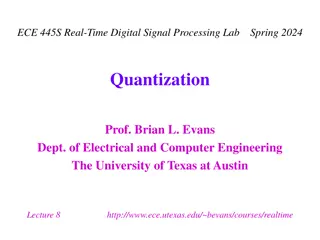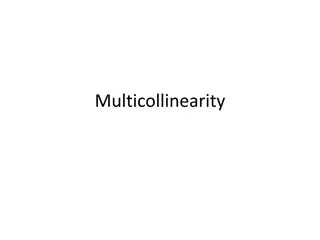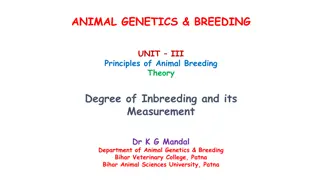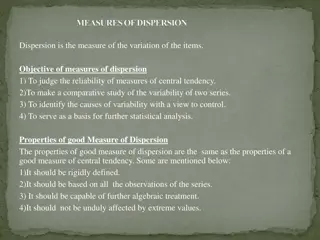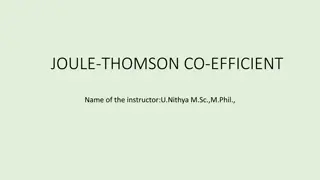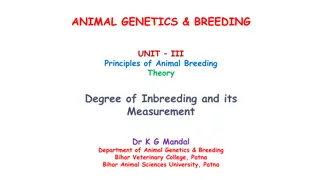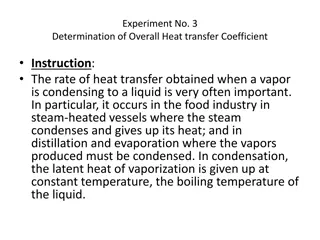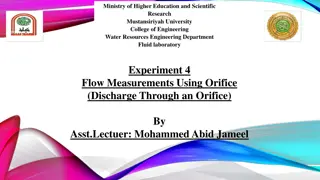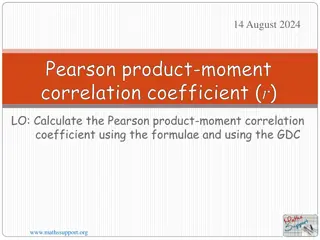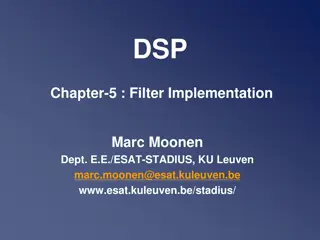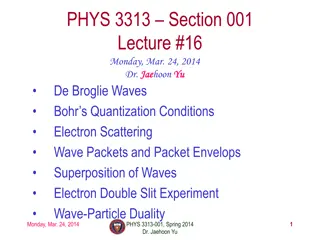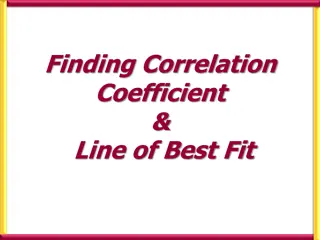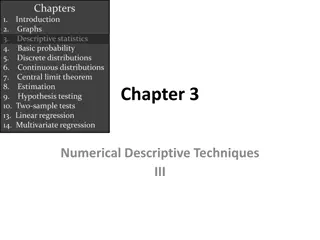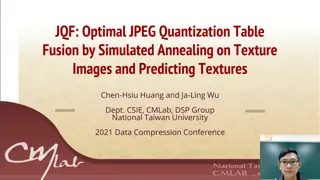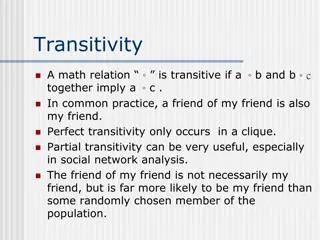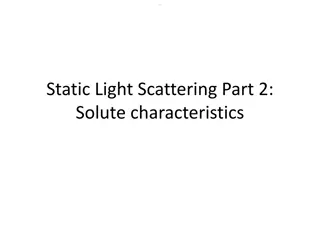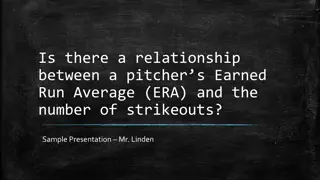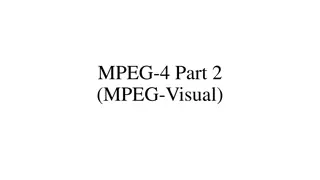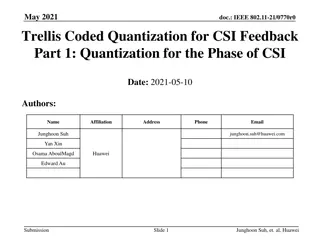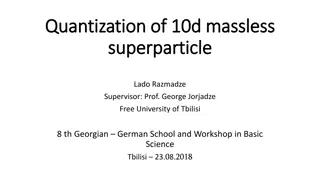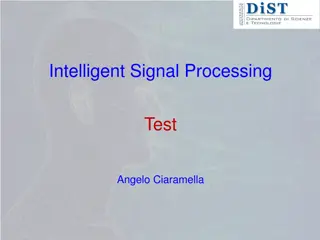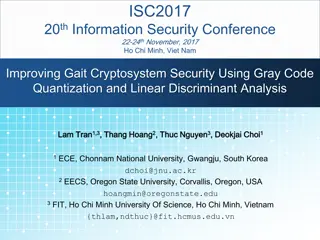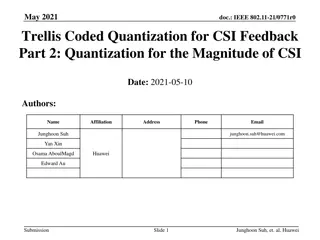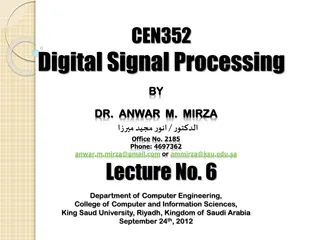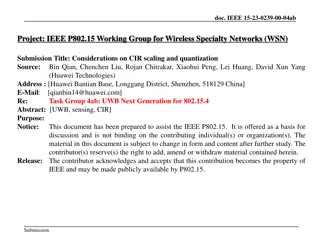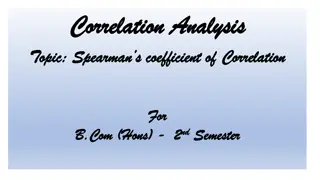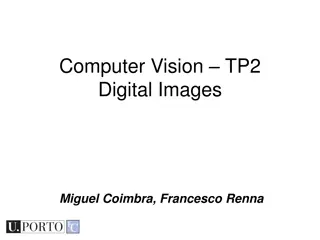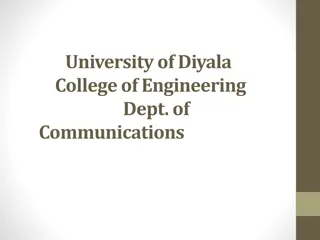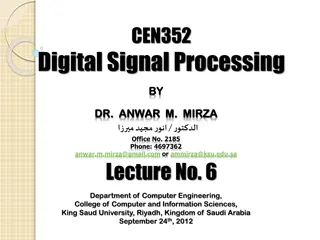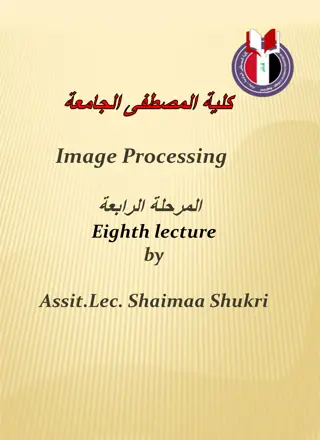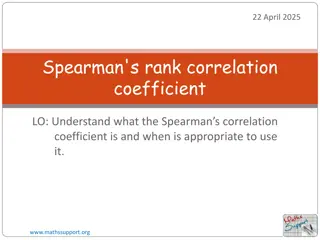Real-Time Digital Signal Processing Lab: Quantization and Resolution Overview
Explore quantization and resolution techniques in real-time digital signal processing. Topics include quantization error analysis, total harmonic distortion, noise immunity in communication systems, human sensory resolution, analog-to-digital conversion, and uniform amplitude quantization. Dive into
7 views • 19 slides
Multicollinearity in Regression Analysis
Multicollinearity in regression occurs when independent variables have strong correlations, impacting coefficient estimation. Perfect multicollinearity leads to regression model issues, while imperfect multicollinearity affects coefficient estimation. Detection methods and consequences, such as incr
1 views • 11 slides
Degree of Inbreeding in Animal Genetics and Breeding
Degree of inbreeding refers to the extent to which an individual carries genes identical by descent. This concept is crucial in animal breeding as it affects genetic diversity and homozygosity in offspring. The coefficient of inbreeding is used to measure the level of inbreeding, with higher values
1 views • 30 slides
DNN Inference Optimization Challenge Overview
The DNN Inference Optimization Challenge, organized by Liya Yuan from ZTE, focuses on optimizing deep neural network (DNN) models for efficient inference on-device, at the edge, and in the cloud. The challenge addresses the need for high accuracy while minimizing data center consumption and inferenc
1 views • 13 slides
Measures of Dispersion in Statistics
Measures of dispersion in statistics help in understanding the variability of data points. They are essential for assessing the reliability of central tendency measures, comparing data sets, identifying variability causes, and guiding further statistical analysis. The properties of a good measure of
2 views • 8 slides
Joule-Thomson Coefficient in Thermodynamics
The Joule-Thomson coefficient describes the relationship between temperature and pressure changes in a substance. This coefficient impacts the direction of temperature change when pressure is altered. With equations and explanations provided by U. Nithya, M.Sc., M.Phil., this summary covers the defi
3 views • 11 slides
Degree of Inbreeding and its Measurement in Animal Genetics and Breeding
Degree of inbreeding in animals is the extent to which genes are identical by descent within an individual. The coefficient of inbreeding, denoted by F, measures this degree and represents the increase in homozygosity in offspring from closely related matings. Two sources of homozygosity are genes a
2 views • 15 slides
Determination of Overall Heat Transfer Coefficient in Steam Condenser Experiment
The experiment focuses on determining the overall heat transfer coefficient in a steam condenser, crucial for industries like food processing, distillation, and evaporation. A shell-and-tube heat exchanger setup is used with a steam boiler, measuring the heat transfer rate during vapor condensation.
0 views • 18 slides
Flow Measurements Using Orifice: Experiment in Fluid Laboratory
Understanding the principles of flow measurement through an orifice meter is essential in engineering. This experiment aims to determine the discharge coefficient of an orifice meter, analyzing the theoretical aspects and addressing sources of error such as mechanical losses and the vena contracta.
3 views • 13 slides
Partition Coefficient in Pharmaceuticals
Partition coefficient (P.C.) is crucial in pharmaceuticals for various reasons such as preserving oil/water systems, drug distribution in the body, extraction processes, and dosage form formulations. It involves the distribution of a solute between two immiscible liquids based on equilibrium express
0 views • 10 slides
Pearson Product-Moment Correlation Coefficient
Pearson product-moment correlation coefficient, denoted by "r," is a numerical measure of the strength and direction of a linear relationship between two variables. It ranges from -1 to +1, where 1 signifies a perfect positive linear correlation, -1 a perfect negative linear correlation, and 0 no co
0 views • 18 slides
Chapter 5: Filter Implementation and Finite Word-Length Problem Overview
This chapter delves into the implementation challenges of digital filters, particularly focusing on the finite word-length problem. It discusses issues such as coefficient quantization, arithmetic operations, quantization noise, statistical analysis, limit cycles, and scaling. Various realizations a
1 views • 32 slides
De Broglie Waves, Bohr's Quantization, and Electron Scattering in Physics
Discover the fascinating concepts of De Broglie waves, Bohr's quantization conditions, and electron scattering in physics. Delve into the wave-particle duality, electron double-slit experiments, and the groundbreaking observations by Davisson and Germer. Uncover the implications of mass particles ha
1 views • 23 slides
Correlation Coefficient and Line of Best Fit
Learn how to find the correlation coefficient and create a line of best fit using statistical and regression calculations. Discover the steps involved, from setting up the calculator to analyzing the input data and determining the correlation between variables.
1 views • 14 slides
Measures of Linear Relationship in Statistics
Exploring the concepts of covariance and correlation coefficient in statistics to determine the strength and direction of linear relationships between variables. Covariance indicates the pattern two variables move together, while correlation coefficient quantifies the strength of the relationship. S
0 views • 35 slides
Optimizing JPEG Quantization Tables Using Simulated Annealing on Texture Images
Optimization of JPEG quantization tables is a challenging task due to the vast solution space and lack of reliable quality measurement. This paper introduces a method that combines texture mosaic images and simulated annealing to find an optimal quantization table. The framework involves texture clu
0 views • 9 slides
VIIRS Land Surface Temperature (LST) Calibration Approach and Data Analysis
The VIIRS Land Surface Temperature (LST) Provisional Status project, led by Dr. Yunyue Yu, focuses on improving the LST EDR through algorithm coefficient updates and calibrations. The calibration process involves regression steps and comparisons with reference datasets like MODIS Aqua LST. Various c
1 views • 29 slides
Transitivity and Clustering Coefficient in Social Networks
Transitivity in math relations signifies a chain of connectedness where the friend of a friend might likely be one's friend, particularly in social network analysis. The clustering coefficient measures the likelihood of interconnected nodes and their relationships in a network, highlighting the stru
1 views • 8 slides
Light Scattering Part 2: Solute Characteristics and Applications
Light scattering can provide valuable insights into solute characteristics such as molecular weight, radius of gyration, and second virial coefficient. By analyzing scattering data, information about individual particles and their arrangement in solution can be obtained. Techniques like Zimm or Guin
2 views • 20 slides
Overview of Impedance and Reflection Coefficient in 1-Port Network Transmission Lines
Explore the fundamentals of 1-port networks, focusing on impedance, admittance, and reflection coefficient. This lecture from EEE 212 delves into the review of these key concepts essential for modern antenna design. Drawing insights from HP/Agilent Application Note 95-1, the discussion provides a fo
0 views • 140 slides
Pitcher's ERA and Strikeout Relationship in Baseball
An analysis was conducted to investigate the relationship between a Major League pitcher's Earned Run Average (ERA) and the number of strikeouts during the 2018 regular season. Using a simple random sample of 30 pitchers, a correlation coefficient of -0.376 was found, indicating a moderately weak ne
2 views • 10 slides
MPEG-4 Video Coding
MPEG-4 video coding involves various tools and techniques such as MPEG-Visual, Simple Profile, Quantization Methods, Motion Compensation, Coding Efficiency Tools, Transmission Efficiency Tools, and Advanced Simple Profile. These tools define specific features, coding functions, and constraints for o
0 views • 27 slides
May 2021: Trellis Coded Quantization for CSI Feedback - Part 1
CSI feedback in wireless communication systems plays a crucial role in optimizing information transmission. This document discusses trellis coded quantization techniques for improving the feedback process, focusing on quantization for the phase of Channel State Information (CSI). The article delves
0 views • 18 slides
Quantization of 10D Massless Superparticle by Lado Razmadze
Delve into the fascinating world of quantizing gauge theories and relativistically invariant theories in curved spacetime through the study of 10D massless superparticles. Explore the algebraic approach using the Faddeev-Jackiw method, covariant quantization principles, and the use of Darboux's theo
0 views • 17 slides
Quantization of 10D Massless Superparticle
Investigate the quantization of a 10-dimensional massless superparticle through algebraic methods and covariant quantization of gauge theories in curved spacetime. Explore the use of Faddeev-Jackiw method, Hamiltonian reduction, canonical variables, inner product definitions, and Brink-Schwartz acti
0 views • 20 slides
Finding Correlation Coefficient & Line of Best Fit
Analyze the correlation coefficient and determine the best fit line for your data. Understand the relationship between variables and predict future outcomes accurately. This process involves calculating the correlation coefficient value and fitting a line that represents the data trend. By interpret
1 views • 12 slides
Intelligent Signal Processing in Quantization: Understanding Error Calculation
The concept of quantization in intelligent signal processing, focusing on error calculation methods and common word-lengths. Learn about uniform and non-uniform quantization, bit rate calculation, and examples of quantization techniques.
0 views • 14 slides
Enhancing Gait Data Security Using Gray Code Quantization
This paper discusses techniques to improve the security of gait data in biometric cryptosystems by addressing issues such as low discriminability and high data variation. The proposed methods involve utilizing Linear Discriminant Analysis and Gray Code Quantization to enhance security and reduce fal
0 views • 25 slides
Trellis Coded Quantization for CSI Feedback Part 2: Magnitude Quantization
In this document, the authors delve into applying Trellis Coded Quantization (TCQ) to the magnitude of Channel State Information (CSI) feedback. They discuss converting Rayleigh-distributed samples to uniformly distributed samples for quantizing the CSI magnitude. The content covers statistics of Ra
0 views • 17 slides
Digital Signal Processing Essentials
Explore the fundamentals of digital signal processing, including techniques such as PCM and Delta Modulation, Quantization, and Analog to Digital Conversion. Learn how to convert analog data into digital form for transmission efficiently. Gain insights into the sampling and quantization processes vi
0 views • 58 slides
Understanding Quantization of Charge, Light, and Energy in Radiation Phenomena
Explore the groundbreaking experiments of Thompson and Millikan that revealed the quantization of charge, delve into the concept of radiation and black body radiation, and learn about the laws governing radiant energy emission such as the Planck Radiation Law and Stefan-Boltzmann Law.
0 views • 8 slides
Digital Signal Processing and Quantization Concepts
Explore the fundamentals of digital signal processing and quantization, where analog signals are converted into digital signals through finite precision representation. Learn about quantization error and noise, along with examples illustrating quantization techniques using truncation and rounding.
0 views • 13 slides
Considerations on CIR Scaling and Quantization in UWB Next Generation
Explore the considerations on Channel Impulse Response (CIR) scaling and quantization in the context of Ultra-Wideband (UWB) technology for the next generation of wireless networks. This document discusses interference mitigation techniques, backward compatibility, improved link budget, and proposed
0 views • 17 slides
Neural Network Quantization for Overhead Reduction in AIML Model Sharing
Explore the implementation of neural network quantization for reducing communication overhead in AIML model sharing. Discussing the sharing of model parameters between STAs and the benefits of quantization in reducing computational complexity and storage requirements. Learn about different categorie
1 views • 13 slides
Spearman Rank Correlation Analysis: Understanding and Application
Learn about Spearman's coefficient of correlation, its importance in analyzing the strength and direction of associations between ranked variables, and the process of ranking data systematically to calculate the Spearman rank correlation coefficient. Explore how to interpret the coefficient values a
1 views • 13 slides
Digital Images in Computer Vision TP2 - Sampling, Quantization, and More
Explore the world of digital images in Computer Vision TP2, covering topics such as sampling, quantization, image structures, and components of a computer vision system. Learn about the pinhole camera model, simple image representation, analog-to-digital conversion, and images as matrices. Understan
0 views • 27 slides
Understanding Quantization in Digital Communications
Learn about quantization in digital communications, including uniform and non-uniform quantization techniques, processes, advantages, and disadvantages. Explore examples and types of quantization to enhance your knowledge in the field of communications engineering.
0 views • 10 slides
Digital Signal Processing and Quantization: Understanding Analog Signals
Explore the concept of quantization in digital signal processing through examples of analog signals being converted into discrete-time signals, illustrating the effects of truncation and rounding on the quantization process.
0 views • 13 slides
Image Processing Lecture by Assit. Lec. Shaimaa Shukri
Explore the eighth lecture on Image Processing by Assistant Lecturer Shaimaa Shukri, covering topics like image quantization, gray level reduction, and contouring effects. Learn about methods to reduce image data and enhance visual appearance through quantization techniques.
0 views • 23 slides
Understanding Spearman's Rank Correlation Coefficient in Data Analysis
Learn about Spearman's rank correlation coefficient, its application, and how it differs from Pearson's correlation coefficient. Explore how to interpret rank correlation coefficients for non-linear data trends.
0 views • 14 slides
